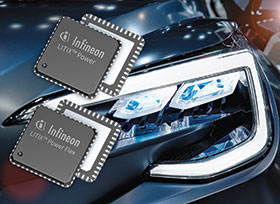

LEDs in automotive front lighting enable energy savings, new light designs and applications, such as matrix beam and laser high-beam. Supporting the progress in automotive lighting, Infineon Technologies launched high-power LED drivers specifically designed for automotive front lights.
The drivers are available within the new LITIX Power Flex series and the LITIX Power series. They address flexible DC-DC driver solutions supporting LED systems of up to 50 W and even above. Application setups can vary: many medium-power LEDs with string voltages of up to 55 V, or few LEDs with high currents of up to 3 A and more.
Both LED drivers, the LITIX Power Flex TLD5541-1QV and the LITIX Power TLD5190QV, are well-suited for high-power and high-current LED applications. These include, for example, front lighting, laser and LED headlamps. They also suit high-efficiency supplies for LED applications working on battery voltage. Furthermore, they allow cost-optimised full-LED front light applications for cars, and even motorcycles with their space limitations in the handlebar’s headlamp.
LITIX Power Flex
The TLD5541-1QV is the first available member of the new multi-topology DC-DC controller family LITIX Power Flex. The synchronous H-bridge DC-DC controller is ideal for driving all high-power LED configurations with system efficiency of well above 92%. Thanks to its optimised spread spectrum switching frequency, the device helps reduce EMC emissions to fulfill challenging EMC requirements like CISPR 25 class 5.
The TLD5541-1QV features seamless buck-boost regulation and fast dynamic load jump behaviour. Therefore, it enables cost-optimised LED headlamps with complete protection and diagnosis features. Just one chip can drive two and more separately switched LED loads in one string, with up to 55 V string voltage. The LED current accuracy is specified with ±3%. The TLD5541-1QV with built-in protection features and SPI interface offers both analog and digital (PWM) dimming. The switching frequency is adjustable in the range of 200 kHz to 700 kHz, and the adjustable soft start feature limits the current peak as well as voltage overshoots at startup.
LITIX Power
The LITIX Power family of DC-DC converters and controllers targets medium-power to high-power applications. These comprise LED daytime running lights and LED low-beam and high-beam. The new family member TLD5190QV is a synchronous H-bridge DC-DC controller with similar features to the TLD5541-1QV. Without an SPI interface, it particularly suits LED control electronics where no microcontroller is needed, while it is easy to implement. The device also offers integrated protection functions, both analog and digital (PWM) dimming, and an adjustable switching frequency in the range of 200 kHz to 700 kHz.
Both controllers are already in volume production and available in VQFN-48 packages, and they are suitable for use in harsh automotive environments and specified according to AEC-Q100. Infineon supports design-in with demo boards, data sheets and PSpice simulation models.
For more information contact Dirk Venter, Arrow Altech Distribution, +27 (0)11 923 9600, [email protected], www.arrow.altech.co.za
| Tel: | +27 11 923 9600 |
| Fax: | +27 11 923 9884 |
| Email: | [email protected] |
| www: | www.altronarrow.com |
| Articles: | More information and articles about Altron Arrow |
© Technews Publishing (Pty) Ltd | All Rights Reserved